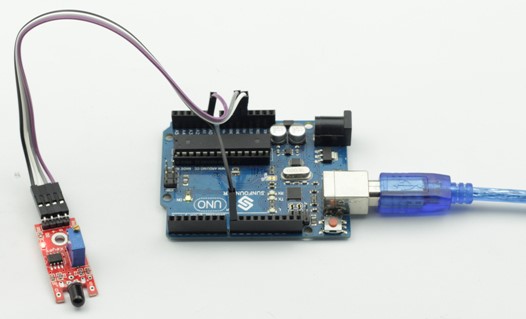Introduction
A flame sensor module performs detection by capturing infrared wavelengths from flame. It can be used to detect and warn of flames.

Components
– 1 * SunFounder Uno board
– 1 * USB data cable
– 1 * Flame sensor module
– Several jumper wires
Experimental Principle
There are several types of flame sensors. In this experiment, we will use a far-infrared flame sensor. It can detect infrared light with a wavelength ranging from 700nm to 1000nm. A far-infrared flame probe converts the strength changes of the external infrared light into current changes. And then it converts analog quantities into digital ones.
In this experiment, connect pin D0 to D8 of the SunFounder Uno board. When the flame sensor detects flame signals, the LED attached to pin 13 of the Uno board will brighten. Otherwise, it will keep off.
Experimental Procedures
Step 1: Build the circuit
Flame Module SunFounder Uno
AO —————————————— A0
G ——————————————- GND
+ ——————————————— 5V
DO —————————————— D8
Step 2: Program (Please refer to the example code in LEARN -> Get Tutorial on our website)
Step 3: Compile
Step 4: Upload the sketch to SunFounder Uno
Now, ignite a lighter near the flame sensor, and the LED on the module and that attached to pin 13 on Uno will light up.

Code
| const int analogInPin = A0; const int digitalInPin = 8; const int ledPin = 13;void setup() { pinMode(digitalInPin,INPUT); pinMode(ledPin,OUTPUT); }void loop() { int analogVal = analogRead(analogInPin); boolean stat = digitalRead(digitalInPin); if(stat == HIGH) { digitalWrite(ledPin,HIGH); } else { digitalWrite(ledPin,LOW); } } |
